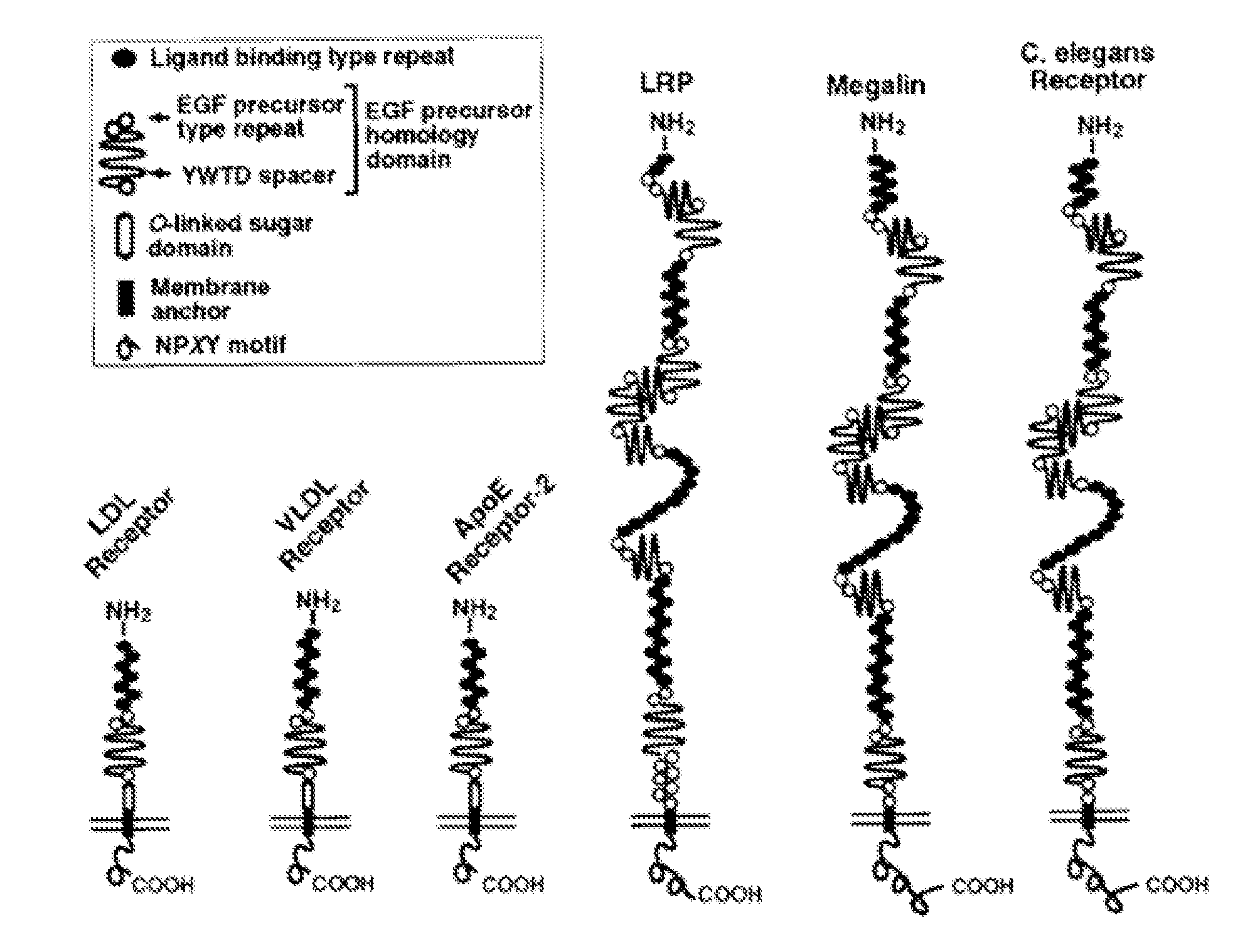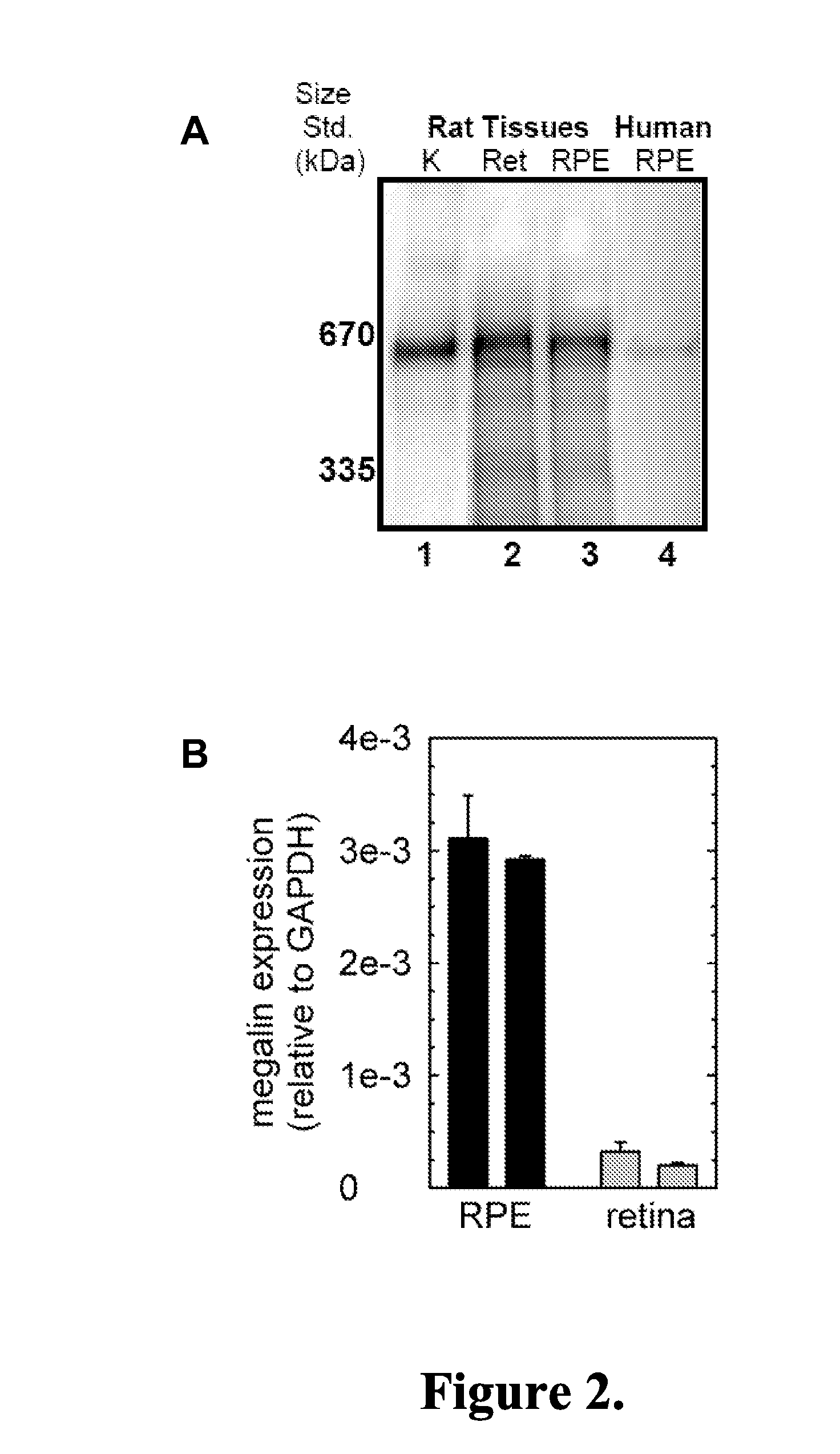Methods and compositions for treating ophthalmic conditions via modulation of megalin activity
a megalin activity and ophthalmic condition technology, applied in the direction of drug compositions, antibody medical ingredients, peptide/protein ingredients, etc., can solve the problems of limited treatment options for ophthalmic conditions, and achieve the effect of increasing the removal of lipofuscin
- Summary
- Abstract
- Description
- Claims
- Application Information
AI Technical Summary
Benefits of technology
Problems solved by technology
Method used
Image
Examples
example 1
Effect of a Megalin-Modulating Agent on A2E Accumulation
[0513]Administration of a Megalin-modulating agent to an experimental group of mice and administration of DMSO alone to a control group of mice is performed and assayed for accumulation of A2E. The experimental group is given 2.5 to 20 mg / kg of the Megalin-modulating agent per day in 10 to 25 μl of DMSO. Higher dosages are tested if no effect is seen with the highest dose of 50 mg / kg. The control group is given 10 to 25 μl injections of DMSO alone. Mice are administered either experimental or control substances by intraperitoneal (i.p.) injection for various experimental time periods not to exceed one month.
[0514]To assay for the accumulation of A2E in abca4− / − mice RPE, 2.5 to 20 mg / kg of a Megalin-modulating agent is provided by i.p. injection per day to 2-month old abca4− / − mice. After 1 month, both experimental and control mice are killed and the levels of A2E in the RPE are determined by HPLC. In addition, the autofluoresc...
example 2
Effect of a Megalin-Modulating Agent on Lipofuscin Accumulation
[0515]Administration of a Megalin-modulating agent to an experimental group of mice and administration of DMSO alone to a control group of mice is performed and assayed for the accumulation of lipofuscin. The experimental group is given 2.5 to 20 mg / kg of the Megalin-modulating agent per day in 10 to 25 μl of DMSO. Higher dosages are tested if no effect is seen with the highest dose of 50 mg / kg. The control group are given 10 to 25 μl injections of DMSO alone. Mice are administered either experimental or control substances by i.p. injection for various experimental time periods not to exceed one month. Alternatively, mice can be implanted with a pump which delivers either experimental or control substances at a rate of 0.25 μl / hr for various experimental time periods not to exceed one month.
[0516]To assay for the effects of the Megalin-modulating agent on the formation of lipofuscin in treated and untreated abca4− / − mice...
example 3
Effect of a Megalin-Modulating Agent on Rod Cell Death or Rod Functional Impairment
[0517]Administration of a Megalin-modulating agent to an experimental group of mice and administration of DMSO alone to a control group of mice is performed and assayed for the effects of a Megalin-modulating agent on rod cell death or rod functional impairment. The experimental group is given 2.5 to 20 mg / kg of the Megalin-modulating agent per day in 10 to 25 μl of DMSO. Higher dosages are tested if no effect is seen with the highest dose of 50 mg / kg. The control group is given 10 to 25 μl injections of DMSO alone. Mice are administered either experimental or control substances by i.p. injection for various experimental time periods not to exceed one month. Alternatively, mice can be implanted with a pump which delivers either experimental or control substances at a rate of 0.25 μl / hr for various experimental time periods not to exceed one month.
[0518]Mice that are treated to 2.5 to 20 mg / kg of a Meg...
PUM
| Property | Measurement | Unit |
|---|---|---|
| time | aaaaa | aaaaa |
| time | aaaaa | aaaaa |
| mass | aaaaa | aaaaa |
Abstract
Description
Claims
Application Information
 Login to View More
Login to View More - R&D
- Intellectual Property
- Life Sciences
- Materials
- Tech Scout
- Unparalleled Data Quality
- Higher Quality Content
- 60% Fewer Hallucinations
Browse by: Latest US Patents, China's latest patents, Technical Efficacy Thesaurus, Application Domain, Technology Topic, Popular Technical Reports.
© 2025 PatSnap. All rights reserved.Legal|Privacy policy|Modern Slavery Act Transparency Statement|Sitemap|About US| Contact US: help@patsnap.com



